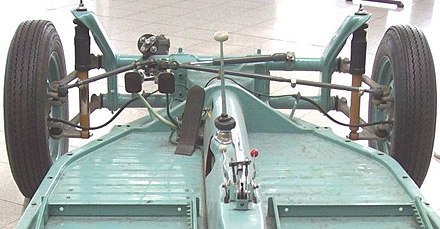Crank arm axle

The crank arm axle (also double trailing arm axle or support lever axle ) is a front independent wheel suspension on automobiles developed by Ferdinand Porsche . The name is derived from the trailing arms used by him and known as "crank arms " (or "carrying levers") to guide the wheels . Most VW Beetles have this type of front axle (see first illustration).
Each front wheel is suspended from two crank arms of equal length that connect the wheel carrier to the chassis . Since the distances between the bearings on the chassis and those on the wheel carrier are the same, it is a parallel crank drive . The wheel carrier is therefore always parallel to the connecting line of the two bearings on the vehicle frame when the wheel is compressed, and the track width , camber and caster remain the same. Only the wheelbase changes slightly.
In the VW Beetle , the inner tube ends of the handlebars protrude into a solid tube. Both fixed tubes together form the axle beam that extends to the other side of the vehicle. There it carries the other wheel. The links are rotatably mounted in the axle body tubes in two pivot bearings around the transverse axis of the vehicle, outside in needle bearings and inside in plastic plain bearings . The torsion bar springs are passed through the hollow axes of rotation of the handlebars and are non-rotatably connected to the handlebars with a clamping screw. The springs are designed as torsionally soft leaf spring bundles and clamped in a square socket in the middle of the axle body tubes. In most versions, the two axle body tubes are connected by lateral "horns" on which the shock absorbers are supported.
In the Auto Union racing car (see second illustration), swivel joint sockets are attached to the ends of the handlebars near the wheel , and the stub axle is connected via a further swivel joint with stub axle bolts. This construction, known as a collar bolt axle in the VW Beetle, was replaced in 1965 by a version with maintenance-free ball joints . (see first figure) In the case of the ball joints, the rotational mobility across the direction of travel was combined with the rotational mobility of the wheel carrier ( stub axle ) around the vertical axis.
The crank arm axle was found in all models from Volkswagen up to 1968, when the 411 appeared with MacPherson struts , but also in the Porsche sports cars of the 356 series , the Grand Prix racing cars of the Auto Union in the 1930s, including the small cars Rear engine from Saporoshez and in the Alfa Romeo racing cars Tipo 158/159 (Alfetta) . Trevor Wilkinson used the Beetle's crank arms on both the front and rear axles on some versions of the Jomar and the TVR Grantura (up to the Mark IIA).

On the crank arm axles that Healey used on Healey Silverstone and Hans Trippel on Amphicar , the two handlebars (cranks) have different cross-sections. The forces acting across the direction of travel and the moments about the longitudinal axis are transmitted exclusively via the stronger link. This he finds in addition to the bending - even an otherwise occurring torsion - stress . The other link can be made slim, it is not involved in the lateral guidance of the wheel and only transmits forces in the longitudinal direction. With the Healey, the handlebars with a larger cross-section are the lower, with the Amphicar the upper.
In the examples mentioned and shown, the handlebars point backwards ("pulled"). The Saab 92 (1949–1956) had a front suspension with pushed-in arms .
See also
Individual evidence
- ↑ Jörnsen Reimpell: chassis technology: wheel suspensions. 1st edition. Vogel Business Media, Würzburg 1986, ISBN 3-8343-3227-5 , p. 339.
- ^ Karl-Heinz Edler, Wolfgang Roediger: The German racing vehicles . Fachbuchverlag Leipzig, 1988, ISBN 3-343-00435-9 , p. 97.
- ↑ Porsche sales brochure W 22 1.60 5 M Gl.
- ↑ The world of cars and motorcycles. Volume 7, Issue 6, DSV Deutscher Sportverlag GmbH, Cologne 1953, p. 172.
- ^ Cyril Posthumus: Classic Racing Cars . Rand McNally & Company, 1977. First published in the UK by the Hamlyn Publishing Group, ISBN 0-528-81843-0 , pp. 62, 64 and 65.
- ↑ http://storm.oldcarmanualproject.com/saab/92/3111.jpg Page from a sales prospectus
